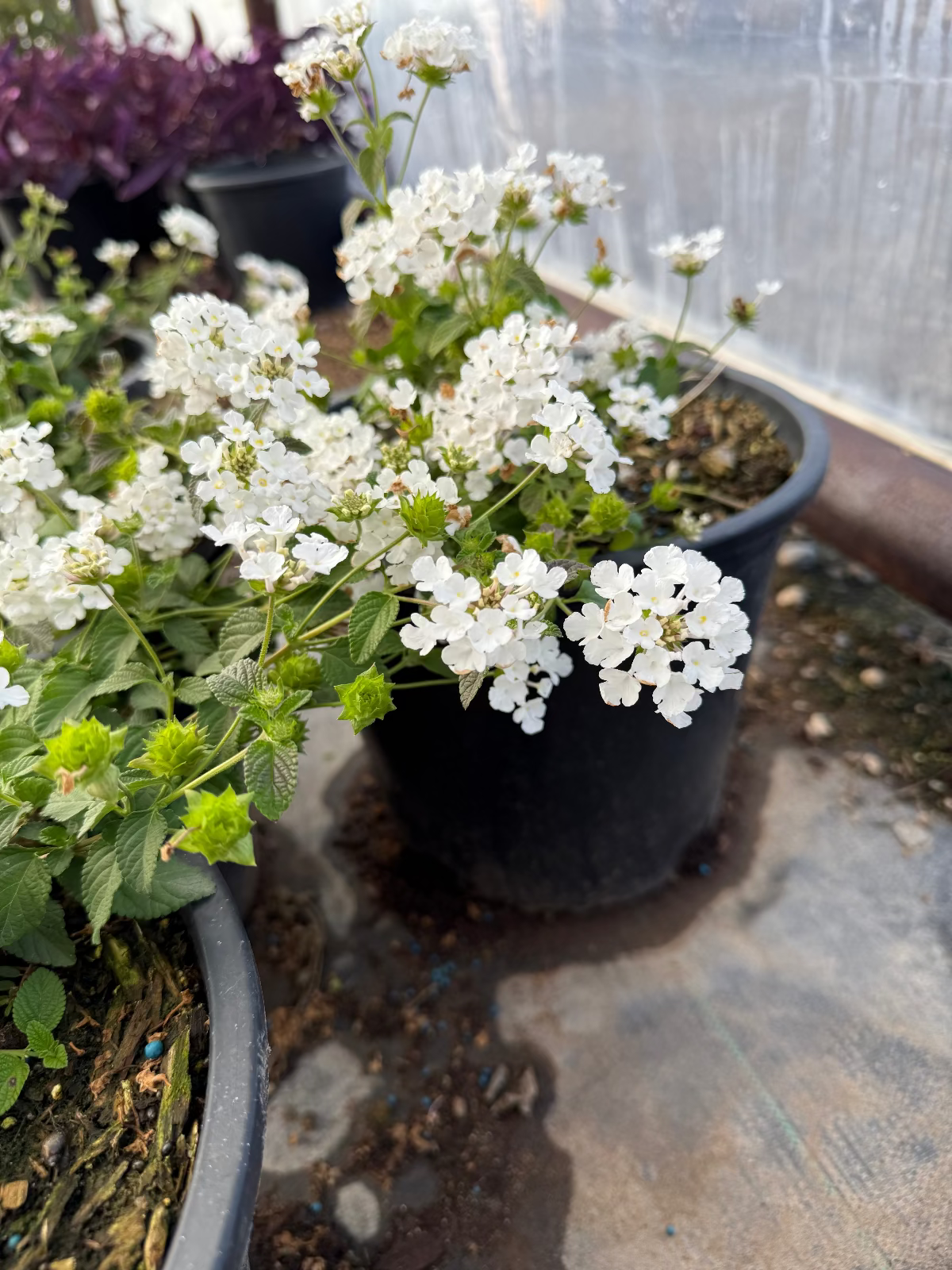My Store
White Trailing Lantana
White Trailing Lantana
Couldn't load pickup availability
Plant Type: perennial
Plant Height: 8-12 inches
Spread: 3-6 feet
Flower Color: white
Sun Exposure: Full Sun
White Lantana (Lantana camara 'Alba') – Elegant, Drought-Tolerant Perennial for Arizona Landscapes
Bring a touch of purity and charm to your Phoenix Valley garden with White Lantana, a resilient and low-maintenance perennial known for its delicate white flowers and fragrant foliage. Scientifically referred to as Lantana camara 'Alba,' this lantana variety offers a serene display of color from spring through fall, adding wildlife-friendly beauty to Arizona landscapes. With its heat tolerance and low water needs, White Lantana is a top choice for sustainable, water-wise gardens that thrive in the desert climate.
Key Features of White Lantana
White Lantana grows to about 2 to 4 feet in height with a similar spread, forming a balanced, bushy shape that adds structure and elegance to any garden. Its small, tubular white flowers bloom in dense clusters, creating a pure, visually captivating display that attracts butterflies, bees, and other pollinators. The plant’s lush, fragrant foliage releases a gentle aroma when touched or brushed against, enhancing its appeal as a sensory addition to outdoor spaces.
Adapted to Arizona’s hot, arid climate, White Lantana is well-suited for full sun and thrives in well-draining soil, providing a dependable source of color and texture even in challenging conditions. Its drought tolerance once established makes it a reliable choice for eco-conscious gardeners focused on water conservation.
Ideal for Water-Wise Gardens in Phoenix Valley
White Lantana’s drought-tolerant nature allows it to flourish with minimal water, making it a perfect option for xeriscaping, low-maintenance landscapes, and sustainable gardens. With its resilience in arid climates, White Lantana can help Phoenix gardeners reduce water usage while maintaining a beautiful and eco-friendly outdoor space.
Versatile Uses for White Lantana in Phoenix Valley Landscaping
-
Borders and Edging Plants: With its bushy form and bright white blooms, White Lantana is ideal for creating a clean, defined border around garden beds, pathways, and driveways.
-
Ground Cover for Sunny Areas: White Lantana’s spreading growth makes it effective as a ground cover for sunny areas, where it provides weed suppression and vibrant color in exposed garden beds.
-
Container Gardens for Patios and Decks: White Lantana’s compact size and elegant blooms make it well-suited for container gardening, adding serene beauty to patios, balconies, and entryways.
-
Butterfly and Pollinator Gardens: With nectar-rich flowers, White Lantana attracts butterflies, bees, and other pollinators, making it an excellent addition to wildlife-friendly gardens and supporting local ecosystems.
Care Tips for Thriving Growth in Phoenix
White Lantana thrives in full sun and well-draining soil. Though drought-tolerant, providing water during the first growing season helps establish a strong root system. Occasional deep watering in the hottest months can encourage more abundant blooms. Light pruning in early spring helps maintain a tidy shape and promotes continuous flowering. With its minimal care needs, White Lantana is perfect for busy gardeners who want enduring beauty with low maintenance.
Why White Lantana is Perfect for Arizona Landscapes
White Lantana offers Phoenix Valley gardeners a sophisticated, resilient plant that stands up to the intense sun and limited water conditions typical of Arizona. Its pure white blooms provide a calming, refreshing contrast to the desert landscape, while its attraction to pollinators adds ecological value. Whether used in borders, as a ground cover, or in containers, White Lantana brings lasting beauty and sustainability to Arizona landscapes. For a drought-tolerant, visually captivating addition to water-wise gardens, White Lantana is an exceptional choice.
Three Timbers Installation Guide (Feel Free to Follow): White Trailing Lantana
Planting Guide:
- Location: Full sun (at least 6 hours of direct sunlight for optimal growth and vibrant blooms)
- Soil: Well-drained, loamy or sandy soil (slightly acidic to neutral soil preferred)
- Spacing: Space plants 2-3 feet apart for optimal growth and to allow them to spread
- Planting Depth: Plant at the same depth as the root ball, ensuring the top of the root ball is level with the surrounding soil surface
- Support: White Trailing Lantana is a ground cover that does not require staking but will spread across the ground and can also be grown in hanging baskets
Watering Guide:
Watering After Planting:
- Initial Watering: Water thoroughly immediately after planting to saturate the root ball and surrounding soil
- Frequency: Water every 4-5 days for the first 2-3 weeks to help establish the root system
- Watering Amount: Provide 1-1.5 inches of water per session for deep watering
When is the Plant Established?
- Timeframe: White Trailing Lantana is considered established after 2-3 months when the roots have spread into the surrounding soil
Watering Once Established:
- Summer: Water every 7-10 days during the hotter months. If temperatures exceed 100°F, increase watering to every 5-7 days. Provide 1.5-2 inches of water per session.
- Winter: Water every 3-4 weeks during the cooler months, depending on rainfall.
Drip Irrigation Setup:
- Placement of Emitters: Place the drip emitters 6-12 inches away from the base of the plant for even watering
- Flow Rate: Use emitters with a flow rate of 1-2 gallons per hour
- Number of Emitters: 1 emitter per plant for even watering distribution
- Adjusting Frequency: In summer, increase watering frequency to every 5-7 days. In winter, reduce to every 3-4 weeks
Share




















